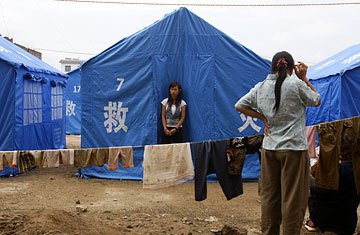
A Burmese refugee looks out from a tent at a refugee camp in China's Yunnan province on Aug. 31, 2009
The refugee crisis comes as the Burmese military regime is tightening its grip on the country ahead of the nationwide election it has announced for next year. Since taking power in 1962, the exclusively ethnic Burman, or Burmese, junta has largely tamed an unruly patchwork of 100-plus ethnic groups, in part by signing cease-fire accords and granting certain minorities a modicum of regional autonomy. But with the upcoming election, ethnic groups with standing armies — such as the Kokang, the Kachin, the Karen and the Wa — have been given until October by the junta to refashion themselves as a centrally controlled border force, or forgo the chance to participate in the election.
Many of these armed groups have already indicated that they are not interested in giving up their already limited sovereignty in return for participating in an election that few believe will be free or fair. Burma's last electoral exercise, in 1990, ended with the non-ethnic National League for Democracy winning the most seats in parliament, with ethnic-based political parties coming in second and third and the junta-backed party finishing fourth. However, the junta ignored the results and kept its grip on power. "Some analyses say that even a rigged election is O.K., if it leads to democracy," says Gun Maw, a high-ranking officer in the Kachin Independence Army, one of the armed ethnic groups operating on the border with China that has decided not to give up its guns. "But it looks like these elections will not lead to democracy, so it is better not to be involved."
The Kokang, under a commander named Peng Jiasheng, recently rejected the regime's border-force offer. Soon afterward, gun battles erupted between the Burmese military and elements of Peng's Myanmar National Democratic Alliance Army, as the Kokang militia is known. Throughout August, the Burmese army made incursions into the Kokang enclave, a region it had largely kept out of since the 1989 cease-fire was signed. The initial reason given by the junta for its forays into Kokang territory was that a weapons factory there was being used to churn out illegal narcotics. Several of the ethnic militias in that part of northeastern Burma have financed themselves through the drug trade.
On Aug. 30, the Burmese state-controlled media finally acknowledged the bloodshed in Shan state, reporting that 36 junta forces had been killed in the fighting. Estimates for Kokang casualties vary widely. But even the Kokang admit that their outnumbered forces have been no match for the invading Burmese army, which now appears to be occupying large parts of Kokang turf.
The Kokang originally came from China, first arriving in Burma in the 17th century. Supporters of the Ming emperors, they fled for exile as that Chinese dynasty disintegrated in 1644. After Burma gained independence from the colonial British, Kokang territory was under the control of Burmese communists, who for decades waged an insurgency against the central government and were among the military regime's most persistent foes. "The [Burmese army] hates many ethnic minorities very much," says Aung Kyaw Zaw, a former anti-junta rebel who now lives in exile in Yunnan province. "But they especially hate the Kokang because they are ethnically Chinese and they used to be communist."
Blood ties may explain why China, which has been one of the Burmese regime's biggest supporters — it has shielded the country from U.N. criticism and poured in foreign investment while Western countries have strengthened economic sanctions — took the unusual step last week of castigating the junta for the Kokang situation. The Chinese Foreign Ministry warned Burma that it should "properly handle domestic problems and maintain stability in the ... border region." The stability-obsessed Chinese government presumably isn't pleased with gun battles on its southern flank, including stray fire that claimed the life of a Chinese citizen in Yunnan.
The border region is a valuable conduit for Burmese natural resources, which China has become increasingly dependent on. For instance, the planned route for a Chinese-financed natural-gas pipeline from western Burma to China runs near the Kokang region. That project is slated to become the biggest-ever foreign-investment commitment in Burma. As Beijing sends People's Liberation Army reinforcements to its land across from the conflict zone, it can only hope that the Burmese regime keeps a fragile peace with the various ethnic groups in other border areas. "This area has always been like a bomb waiting to go off," says the Kachin Independence Army's Gun Maw. "Everyone, from all sides, has to be very careful."
